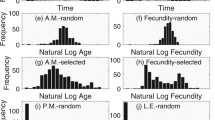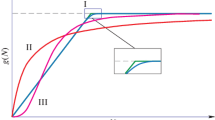Summary
A model was made to clarify the basic processes of competition to occur among larvae by the exploitation as defined byBakker (1969). It was found that this model is applicable to the experimental results on the food exploitation amongDroshophila larvae obtained byBakker (1961). In the model the preimaginal stage is divided into two periods;T f which is the time that a group of larvae spends in exhausting the food after hatching, andT s which is the duration of the starvation period afterT f .T f and thenW l (larval body weight) just after the end ofT f are decided byF s (amount of food supplied per larva at larval hatching) andF c (amount of food consumed per larva).T f affects on the onset ofT s as well asR l (rate of decrease in the individual body weight duringT s ).W a (weight of emerging adults) is gotten by a subtraction ofR l fromW l just after the end ofT f ,R e is affected directly by these components ofW l andR l . As a result,W a andR e are expressed by functions ofF s . This model confirmed that the food exploitation lead to the competition of scramble type. Finally it was suggested that there exist some strategies which prevent ill-effects owing to the food exploitation.
Similar content being viewed by others
Reference
Bakker, K. (1961) An analysis of factors which determine success in competition for food among larvae ofDrosophila melanogaster.Archs. neerl. Zool.14: 200–281.
Bakker, K. (1969) Selection for rate of growth and its influence on competitive ability of larvae ofDrosophila melanogaster.Neth. J. Zool.19: 541–581.
Chiang, H.C. andA.C. Hodson (1950) An analytical study of population growth inDrosophila melanogaster.Ecol. Monogr.20: 173–206.
Clark, L.R., P.W. Geier, R.D. Hughes andR.F. Morris (1967)The ecology of insect population in theory and practice. Methuen, London.
Dixon, A.F.G. (1963) Reproductive activity of the sycamore aphid,Drepanosiphum platanoides (Schr.) (Hemiptera, Aphididae).J. Anim. Ecol.32: 33–48.
Dixon, A.F.G. (1970) Quality and availability of food for a sycamore aphid population. InAnimal Populations in Relation to their Food Resources (Ed. byA. Watson).Symp. Br. Ecol. Soc.10: 271–287.
Glass, N.R. (1967) A technique for fitting nonlinear models to biological data.Ecology48: 1010–17.
Huxley, J.S. (1932)Problems of relative growth, Methuen, London.
Ivlev, V.S. (1961)Experimental ecology of the feeding of fishes. Yale Univ. Pr., New Haven.
Kitching, R. (1971) A simple simulation model of dispersal of animals among units of discrete habitats.Oecologia7: 95–116.
Klomp, H. (1964) Intraspecific competition and the regulation of insect numbers.Ann. Rev. Ent.9: 17–40.
Klomp, H. andB.J. Teerink (1967) The significance of oviposition rates in the egg parasite,Trichogramma embryophagumHtg..Archs. neerl. Zool.17: 350–375.
Lack, D. (1954)The Natural regulation of animal numbers. Oxford Univ. Pr., London.
Miller, R.S. (1967) Pattern and process in competition.Adv. ecol. Res.4: 1–74.
Mishima, J. (1964) The competition amongDrosophila larvae in different growth stages.Res. Popul. Ecol.6: 22–27.
Murai, M. (1966) A statistical consideration on the change of the distribution pattern between two successive stages.Res. Popul. Ecol.8: 8–13.
Murai, M. (1967) Mathematical model for the survivorship curve.Res. Popul. Ecol.9: 75–82.
Murai, M. (1974) Studies on the interference among larvae of the citrus leaf miner,Phyllocnistis citrellaStainton (Lepidoptera: Phyllocnistidae).Res. Popul. Ecol.16: 80–111.
Murai, M. andK. Fujii (1970) Examination of the influences of density pressure on the pattern of adult emergence with reference to the azuki bean weevil,Callosobruchus chinensis. Res. Popul. Ecol.12: 219–232.
Nicholson, A.J. (1955) An outline of the dynamics of animal populations.Aust. J. Zool.2: 9–65.
Nicholson, A.J. (1957) The self-adjustment of populations to change.Cold Spring Harb. Symp. quant. Biol.22: 153–157.
Salt, G. (1961) Competition among insect parasitoids.Symp. Scc. Exp. Biol.15: 96–119.
Shiga, M. andA. Nakanishi (1968) Intraspecies competition in a field population ofGregopimpla himalayensis (Hymenoptera: Icheneumonidae) parasitic onMalacosoma neustria testacea (Lepidoptera: Lasiocampidae).Res. Popul. Ecol.10: 69–86.
Way, M.J. (1967) The nature and causes of annual fluctuations in numbers ofAphis fabaeScop, on field beans (Vicia faba).Ann. appl. Biol.59: 175–188.
Way, M.J. (1968) Intra-specific mechanisms with special reference to aphid populations. InInsect abundance (Ed. byT.R.E. Southwood),Symp. R.ent. Soc. Lond.4: 18–36.
Way, M.J. andM.E. Cammell (1971) Self regulation in aphid population. InDynamics of populations (Ed. byP.J. den Boer andG.R. Gradwell).Proc. NATO adv. Study Inst., Oosterbeek, 1970, pp. 232–242. Pudoc, Wageningen.
Author information
Authors and Affiliations
Rights and permissions
About this article
Cite this article
Murai, M. Theoretical studies on the role of food exploitation for the competition of scaamble type. Res Popul Ecol 16, 289–308 (1975). https://doi.org/10.1007/BF02511068
Issue Date:
DOI: https://doi.org/10.1007/BF02511068




